Pantelis Sabaliotis (Παντελής Σιαμπαλιώτης, also translated into the Latin alphabet Pandelis Siabaliotis or Siampaliotis) * 1955 in Agiopigi, Karditsa, Greece † 2011 in Berlin, Germany.
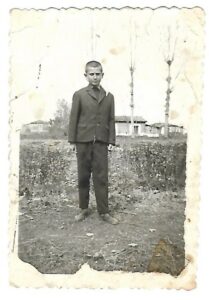 Born in 1955 in the small village of Agiopigi on the Thessalian plain, Pantelis Sabaliotis’ life as an artist was not predetermined. His parents were simple farmers. Greece was in a phase of political upheaval, that had been going on for over 100 years, with mostly catastrophic consequences for the population. The liberation of 400 years of foreign rule by the Ottoman occupation, a process that lasted from around 1820 to 1920, was followed by World War II with occupation by Italians and Germans. After their withdrawal in 1944, a bloody civil war broke out, leftists and the far-right, who wanted to continue the monarchy established by the great Western powers since 1835, fought each other relentlessly. From around 1950, after the defeat of the left, King Paul and, after him, his son King Constantine II, continued the governmental affairs until the colonels putsch in 1967 including the military junta. The King left the country (and will never return due to the abolition of the monarchy decided by referendum in 1973). Pantelis Sabaliotis is 12 years old at the time of the colonels putsch.
Born in 1955 in the small village of Agiopigi on the Thessalian plain, Pantelis Sabaliotis’ life as an artist was not predetermined. His parents were simple farmers. Greece was in a phase of political upheaval, that had been going on for over 100 years, with mostly catastrophic consequences for the population. The liberation of 400 years of foreign rule by the Ottoman occupation, a process that lasted from around 1820 to 1920, was followed by World War II with occupation by Italians and Germans. After their withdrawal in 1944, a bloody civil war broke out, leftists and the far-right, who wanted to continue the monarchy established by the great Western powers since 1835, fought each other relentlessly. From around 1950, after the defeat of the left, King Paul and, after him, his son King Constantine II, continued the governmental affairs until the colonels putsch in 1967 including the military junta. The King left the country (and will never return due to the abolition of the monarchy decided by referendum in 1973). Pantelis Sabaliotis is 12 years old at the time of the colonels putsch.
Thousands of critics, especially left-wing critics, disappear in re-education camps, civil rights are suspended, the media censored, mayoral elections as well as youth organizations and clubs are abolished. All modern literature is forbidden, even Shakespeare, Sophocles and Aristophanes are censored. Life in the village of Pantelis Sabaliotis, about half a day’s march from the Thessalonian economic center of Karditsa, is and remains life under poor conditions. Without infrastructure, electricity, running water- there are almost no perspectives. Beside the field work – the Thessalian plain is considered to be the breadbasket of Greece – the boy goes to school, which he leaves at the age of 14. The „upbringing” imposed by the junta makes him ask too many uncomfortable questions, which remain unanswered . He prefers to spend his time outside instead, in the fields, building fantasy objects and musical instruments out of found materials. The only other things he needs: a pen and a paper. Already at the age of eight, he loses himself in his own worlds of fantasy, he creates in his mind.
He writes a lot – despite those difficult circumstances, he absorbs everything he can obtain relating to knowledge and culture. He is lucky: his older cousin Adonis, neighbor in the same village, is an icon painter. He recognizes the boy’s talent and makes sure he starts his apprenticeship in 1969. Despite his parents’ concerns.
Training Years
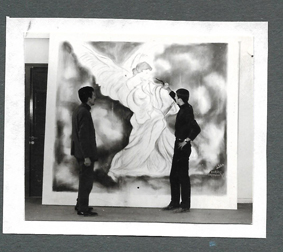 At the age of 14 Sabaliotis is on the road as an apprentice in churches. He can finally paint with colors, learns everything about tempera, gold leaf and fresco painting. Techniques handed down from antiquity, best known from the Egyptian mummy portraits of the Hellenistic Fayum period about 2000 years ago. The secret of their unique luminosity and charisma lies in the encaustic, a type of sealing based on beeswax, a composition passed on from Egypt and Greece over the centuries. This technique was also used for leather, furniture, wooden ships and of course for wall painting as well as marble, later in the Roman Empire, which as a rule was never white, but was painted in bright colors like in ancient Greece. Hence, there were different “recipes”, depending on the needs. “Engafsis” means nothing else than to burn, something is burned or melted. A techniquePantelis Sabaliotis will bring to perfection in his later work. In a completely new dimension: bridging the gap between antiquity, technology and philosophy and modernity – time preserved in wax.
At the age of 14 Sabaliotis is on the road as an apprentice in churches. He can finally paint with colors, learns everything about tempera, gold leaf and fresco painting. Techniques handed down from antiquity, best known from the Egyptian mummy portraits of the Hellenistic Fayum period about 2000 years ago. The secret of their unique luminosity and charisma lies in the encaustic, a type of sealing based on beeswax, a composition passed on from Egypt and Greece over the centuries. This technique was also used for leather, furniture, wooden ships and of course for wall painting as well as marble, later in the Roman Empire, which as a rule was never white, but was painted in bright colors like in ancient Greece. Hence, there were different “recipes”, depending on the needs. “Engafsis” means nothing else than to burn, something is burned or melted. A techniquePantelis Sabaliotis will bring to perfection in his later work. In a completely new dimension: bridging the gap between antiquity, technology and philosophy and modernity – time preserved in wax.
At the age of 16, Pantelis Sabaliotis finished his training as a painter of saints. He clashes with his churchman clients when he got his first commissions. His idiosyncratic interpretations of saints are met with little enthusiasm. The young man’s prospects for a career are therefore limited, what doesn’t bother him, as he sees his path elsewhere. He now has his tools and learned the basics that offer completely different options. So he begins to work on his own projects with tempera, oil paints and canvas. Some of his first works are depictions of Christ, but above all angels or wings appealed to him and will accompany him in various forms over the years. As well as the feminine, which is an essential element in most of his work. He discovered the Surrealists, presumably in books banned by the junta. He is now observing more closely, more intensely. Many portraits were made during this time. Drawings, works in tempera, oil, pastel.
In the years up to 1979 he “reinvents” himself again and again, switching between styles, from realistic to naive painting, from surrealism to geometric art. He imitates, he copies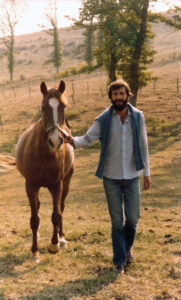 , he composes. Between all of this, he creates works that already show his clear signature. Girls, ethereal, mystical, belonging to another world, play an important role. Monochrome backgrounds, many depictions of horses appear. He discovered many of the topics, his motives, that will accompany him throughout his life as an artist: horses, women’s bodies, the sea, boats, open doors, passages into other dimensions.
, he composes. Between all of this, he creates works that already show his clear signature. Girls, ethereal, mystical, belonging to another world, play an important role. Monochrome backgrounds, many depictions of horses appear. He discovered many of the topics, his motives, that will accompany him throughout his life as an artist: horses, women’s bodies, the sea, boats, open doors, passages into other dimensions.
“One of the most important things in my life was dealing with earth because I grew up on the country side (…) Everyone was impressed by what I was doing, I didn’t consider it more important than that it allowed me to portray all of this in a different way that reflects this feeling of Thessalian country life,, which in a certain way bound and characterized me.”
From the interview with D. Parlavantza, “Kochlias”-magazine, October 4, 2005, pp. 36–39.
Many of the older intellectuals and artists left the country after 1967 – after the junta came to power – to live and find their freedom in other European cities. The 16 years old boy stays in Greece and decides to fight for his freedom aspect teaming up with others of his peers. They organize protests against the military dictatorship. The largest is the “Mysterious Communion of the Peasants” in 1971 in the Karditsa Municipal Theater. A happening, as we would call it today, with a play written by himself, with poems, pictures and an experimental art workshop. Lectures of texts banned by the government are hosted.
Karditsa quickly becomes too confined for the 17-year-old: he wants to discover the world outside this small town. The next stop is Athens, where he founded the gallery “Diamartiria” (the Greek word for „protest“) with other like-minded people, with poets, authors, artists and theater people, in 1972. Events and readings take place in the gallery, writings and books are published. A protest against press censorship and limits in freedom of speech; a plea for a self-determined life.
Sabaliotis is looking for a job and finds a mentor: Vangelis Faϊno. Sabaliotis will later talk about him as his “teacher”. Faϊno owns, what we would call today a small advertising agency and employs the boy as his right hand man. In those two years he will not only work on Giganto Affiches for cinemas, back then, those huge hand-painted canvases advertised films on buildings. Further, he will deal with filigree work, fonts that will occupy him in various forms to the end. Faϊno has its own way of promoting the boy. When he felt he learned everything he can teach , he dismisses him. He gives him a severance payment, on condition that his protégé will soon launch a large solo exhibition.
Military Service and the End of Dictatorship
1973, now being of legal age, Sabaliotis was forced to join the military. As much as Pantelis Sabaliotis acted against the military junta, as much as he boycotted it, as long as he would stay in Greece he had to follow the order if he did not want to risk serious consequences. From the point of view of those in power, however, he was one of those “unwanted persons” who were sent directly to the border in the northeast. To the border river Evros, where the Turkish adversary drove up with tanks more than once. In the same time the conflict in Cyprus came to a head in 1974 and ended in fiasco after an attempted coup supported by the junta government, followed by a takeover attempt by the Greece. Those lead to the division of the island, permanent today. In July of the same year, however, the military government in Greece finally came to an end.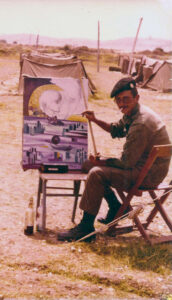
After the end of the junta in 1974, Sabaliotis immediately seized the opportunity for his solo exhibition he promised Faino: “The Ordinariness of Dreams” in the Pialdi Experimental Theatre Marietta in Athens. It will be a great success.
But still 19 years old, he is forced to return to military service. His unit reamins at the Evros. Even if the colonels do not rule anymore, the situation is tense. Political differences with Turkey cannot be bridged due to the situation on Cyprus.
The fundamental problem with authorities that characterized the artist since early youth, the questioning of arrangements, hierarchies and their deeper meaning, continues to accompany him. Especially in military service. Instead of two years of military service, the artist finally does three and a half long years: the summers on the Evros meant scorching heat and mosquitoes, the winters, which, like the summers, were spent in tents, icy cold. The remote world at the border had one advantage: there was always an opportunity to make music or paint.
In 1976, he is finally allowed to return to civilian life again. He founds a painting school in Sofades, a village larger than his home village, close to Karditsa. The first free painting school in Thessaly. Further solo exhibitions in Kastella and Volos follow in 1977 and 1978. The titles already point to his following years of work and artistic life: “The Odyssey brings us to its Origins” and “Sleeping Eurydice”.
On the Road 1979–1988
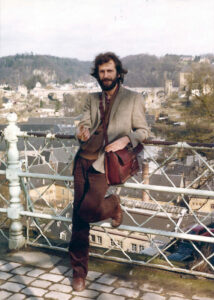 In 1978, the 23-year-old set off to discover the world. With nothing but a travel bag, a drawing pad, a box of pastel pencils and some finished works. A dream, his dream will come true: he will finally see the works of his admired role models in person! To follow Picasso’s brushstroke, the traces of mysticism Max Ernst has left and loose himself in the beauty of Gustav Klimt’s artworks.
In 1978, the 23-year-old set off to discover the world. With nothing but a travel bag, a drawing pad, a box of pastel pencils and some finished works. A dream, his dream will come true: he will finally see the works of his admired role models in person! To follow Picasso’s brushstroke, the traces of mysticism Max Ernst has left and loose himself in the beauty of Gustav Klimt’s artworks.
Pantelis Sabaliotis travels around for almost ten years. He stayed in Paris for a while, a few months in Spain, in the south of France, in Switzerland and in Germany. His very first international exhibition, named “Santorines”, took place in 1979 in Zurich, followed by “Immigrated Caryatids” in September 1980 at the Jean Marc Gallery in Cordes-sur-Ciel (the gallery of the 1952 Toulouse-born artist and photographer Jean-Marc Bustamante).
He turns back to Greece, where he rents a small apartment in the Pagrati district of Athens. On the shelf over his workplace a quote from Jannis Ritsos (Greek writer and poet, 1909–1990), that says: „Through the practice of art I feel a constant detox.”
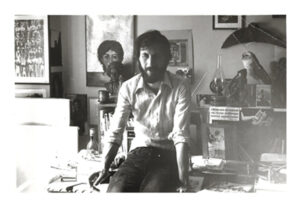 Pantelis Sabaliotis commutes between several European countries, he is in demand, his work quickly finds artadmirers. In June 1981, he exhibits at the Musée d’Enfance de Toulouse Lautrec in Aveyron, southern France. January of that same year, he can be seen in Athens, his works alongside those of Salvador Dalí, who played an important role in Sabalioti’s early surrealist work. It is a great honor for the young artist, almost an award. He has already developed his own style, which only coincides, corresponds with the surrealist on a higher level: the mystical, a world of dreams and nightmares. In Paris Sabaliotis even meets one of his role models personally, Paul Delvaux (a Belgian surrealist), during one of his his last exhibitions. He reached his goal: he had become a free, successful painter in a world that is open to him.
Pantelis Sabaliotis commutes between several European countries, he is in demand, his work quickly finds artadmirers. In June 1981, he exhibits at the Musée d’Enfance de Toulouse Lautrec in Aveyron, southern France. January of that same year, he can be seen in Athens, his works alongside those of Salvador Dalí, who played an important role in Sabalioti’s early surrealist work. It is a great honor for the young artist, almost an award. He has already developed his own style, which only coincides, corresponds with the surrealist on a higher level: the mystical, a world of dreams and nightmares. In Paris Sabaliotis even meets one of his role models personally, Paul Delvaux (a Belgian surrealist), during one of his his last exhibitions. He reached his goal: he had become a free, successful painter in a world that is open to him.
“Women of Troy” is the name of one of the artist’s first series of works in his unmistakable, personal style. The closeness to the sea, to the Thessalian earth will accompany him his lifetime. Likewise, the preoccupation with antiquity, with the origins of civilization.
But do you have to know the gods and heroes of Greek mythology, the stories of Oedipus and Kassandra, to understand the artist’s work? Not necessarily.To him they are nothing but a brief moment of inspiration. He completes those thoughts, achieves differing conclusions, obtains different knowledge as his ancestors, redirects them and bridges ancient and modern.
For the artist, the idea, the knowledge, was the highest value in life, the highest value in civilization. These foundations of philosophical and scientific thinking are also revealed for example in drifting, in observing the water. Boats therefore not only mean movement to Sabaliotis, but symbolize life itself, a symbol for mankind and his tirelessly search for knowledge. Body, soul and mind find a unity, perfection in harmony. Just like in the Greek profile, the ideal of beauty of antiq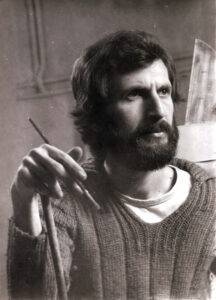 uity, which corresponded to the ideal union of mind and body with a harmoniously smooth transition between the nasal root and forehead. The perfect harmony of body and mind. A thought that was conceived a long time ago, which had a decisive influence on ancient Greek art and continues to live in Sabalioti’s work in contemporary art in Greece.
uity, which corresponded to the ideal union of mind and body with a harmoniously smooth transition between the nasal root and forehead. The perfect harmony of body and mind. A thought that was conceived a long time ago, which had a decisive influence on ancient Greek art and continues to live in Sabalioti’s work in contemporary art in Greece.
„Archegoni nichta“ („Primal Night“) is the title of the trilogy, which includes over a hundred works, mainly pastel. Created in three long winters in Lund, Sweden in 1985, 1986 and 87. The artist himself described the creative process as a search for that very special northern light, which only replaces the long nights for a short time. And not without cause he depicted his work as female as in the focus of this trilogy, these series of work is exclusively the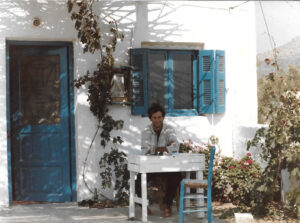 female body.
female body.
But it is also remarkable that these bodies gradually became more abstract. From 1985 the bodies loose more and more their shape, dissolve. In the work series Archegoni nichta. In other work series such as Dada and Venthisikimi he returns once more to the physical but in a magical realistic context. After 1997 there are no more clearly recognizable images, bodies of women. But the feminine as a perception remains elementary, as a roundness that calms every tension on the surface.
The artist’s works were not only shown in galleries in France and Berlin of the 80s, they were also demanded in Greece, where he presented new series of works almost every year in Thessaloniki and Athens. So, he did not only travel Western Europe, he also commuted through several places in Greece. Having said this, there is one place to which he keeps returning; an island, on which he spends several summers: the Cycladic island of Naxos. There is no other place in the world, the blue of the Aegean seem more intense to him. No place, the artist felt closer to the myths than on the island of Ariadne and Dionysus.
Time of Change, Hydra 1989-93
After all those years of travelling Pantelis Sabaliotis at the end will not choose Naxos, but Hydra to settle down. A tiny island off the Peloponnese, reachable in 1 ½ hours by hydrofoil from Athens. But size is not everything. The tiny island of Hydra is even for Greece something very special. The barren island was settled late, namely in the 16th and 17th centuries, because the people back then felt more safe on the island compared to the mainland. The first larger ship was built in 1650. The real upswing followed some time later with inhabitants from the island, who were freed from captivity in Algeria, who had to toil in shipyards and brought the know-how that was in demand. As 1715 the Venetians who predominated in the area lost their last bases in the Peloponnese, Hydra’s trade expanded suddenly. More income in turn meant more investments in larger ships. And after the compass and maps were brought from Venice, hydriots already sailed the Bosporus at the end of the 18th century. In 1812, at the height of power, 106 two- and three-masters and 27 schooners sailed under the flag of Hydra. Lot of them helped breaking through English blockades in front of French ports, whereby some of the capatins from Hydra gained a fortune. The most daring of them is said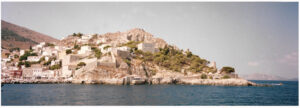 even made it as far as America.
even made it as far as America.
1774 to 1815 is the time of Hydra’s economic boom. The wealth of this time is characterized by the port’s architecture. Characteristic for Hydra are large stately buildings, so-called “Archontika”, former and often also present-day private residences of rich families.
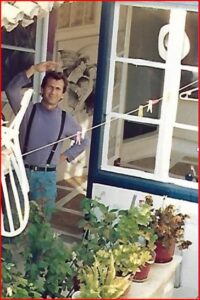 Nowadays, the island is left with day tourists, but as well wealthy Greeks and foreigners, who have bought themselves in the idyll, which can be reached quickly from Athens, like Leonard Cohen or Jannis Kounellis. You will only find two cars on the whole island, instead you will meet many mules and horses on the endless stairs next to the water taxis. Your own legs are a useful means of transport as well. The island is often referred to as „the island of artists“. Not only because of the artists that settled down, but also because of the Athens School of Art that affords itself a branch right at the port.
Nowadays, the island is left with day tourists, but as well wealthy Greeks and foreigners, who have bought themselves in the idyll, which can be reached quickly from Athens, like Leonard Cohen or Jannis Kounellis. You will only find two cars on the whole island, instead you will meet many mules and horses on the endless stairs next to the water taxis. Your own legs are a useful means of transport as well. The island is often referred to as „the island of artists“. Not only because of the artists that settled down, but also because of the Athens School of Art that affords itself a branch right at the port.
In 1989 Pantelis Sabaliotis rents a 200-year-old house, a little above the Kondourioti mansion, which has now been converted into a museum. He moves into the upper floor with three rooms, a small inner courtyard and a kitchen, from the balcony of which one has a wonderful view down to the harbor and the sea. Two corners further is the house of Leonard Cohen, whom the artist will meet several times in the narrow alleys over the years. They greet each other friendly. But Cohen rarely comes. After buying the house in 1962 for $ 1,500 and enjoying the seclusion of the island with the Johnstons and Marianne Ihlens, he left Greece after the coup and the resulting military dictatorship in 1967 to go to New York. The five years on Hydra are an intense time for Cohen, in which he changes a lot artistically. And just as Cohen discovered writing and music for himself on the island twenty years before him, Sabaliotis also came to completely new approaches to his art in the four years that he lived on Hydra. He turns to natural materials and their infinite possibilities. And just like in some of Leonard Cohen’s lyrics produced many years after his residence on Hydra like in “So long Marianne” and “Bird on the Wire”, you will find as well material from Hydra years later in new masterpieces.
The first time since he left Karditsa in 1971 the artist settled down for a longer time period. He finds new inspiration in long, lonely winters and turbulent summers. He is looking for larger formats, tries his hand at oil, acrylic, and various other materials. He collects the remains of palm branches and turns them into art. He carves, he composes, he assembles pieces into abstract works of art, the titles of which, however, still reveal the close relationship to mythology: Kassandra or Sirens. Nature becomes part of his works. He lives in and with it and integrates it into his work: “Geohistorima“, history of earth, is the name of the series of works that is being created. The first of one of other, very different series that follow and range from “Phenomens” to “Metaplaseis” (“Transformations”, starting 2004), the golden sheen of which will accompany him on the very last journey.
“At first glance, he borrows materials (wood, hay, earth, salt, rust, etc.) from nature that are inconspicuous and transforms them with disarming simplicity into symbols, ideas, images, into true works of art,” wrote Panagiotis Nanos in an article about Sabaliotis in the Reportaz newspaper (May 10, 2001).
Hydra means turning towards materiality, discovery of matter, departure towards object art. The mixing and supplementation of yesterday with today also continues in the techniques used: traditional techniques such as encaustic and egg tempera find a completely unique manner with new ones like acrylic painting, which the artist has tried out over the years and pursued to perfection. It almost seems like he needed isolation, seclusion for his own artistic development. Like a caterpillar that pupates into metamorphosis. He will not do a single exhibition in all the years he spends on Hydra. Only a few works will be made available by him for the occasion of the 1991 Lifestyle Fair in Tokyo.
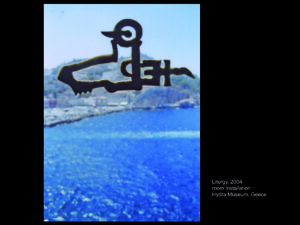 A close friendship with Vangelis Rafalias develops during the time on Hydra. Both, the local pharmacist and the artist, share a passionate interest in history: Rafalias can look back on a long family history, the house full of testimonies from past centuries. It is thanks to his initiative that around 10 years later, in 2004, in the newly founded Historical Archive Museum, Sabaliotis is able to present a larger selection of the works created on Hydra. The exhibition is named “Liturgy in symphony with nature”.
A close friendship with Vangelis Rafalias develops during the time on Hydra. Both, the local pharmacist and the artist, share a passionate interest in history: Rafalias can look back on a long family history, the house full of testimonies from past centuries. It is thanks to his initiative that around 10 years later, in 2004, in the newly founded Historical Archive Museum, Sabaliotis is able to present a larger selection of the works created on Hydra. The exhibition is named “Liturgy in symphony with nature”. 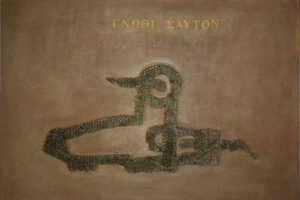
„Recognize yourself” (“Gnothi savton”) is a fundamental thought in the work of the artist. Because far beyond the material and nature, it is the human mind that gives shape to a work of art. Sabaliotis’ works are ultimately the result of an attitude of mind, of philosophical thinking. A thinking that is closely related to names like Anaximandros, Thalis and Heraclitus, as well as other philosophers of the pre-Socratic period, who deal with the subject of matter. The much-quoted sentence, which is ascribed to the 7 wise men as well as to Pythia himself, adorned one of the columns in the entrance area of the Temple of Apollo in Delphi, according to tradition. Inside the omphalos, who was considered the center (navel) of the world. Erected where, according to myth, the two eagles met, which Zeus had let fly in opposite directions at the same time. A holy place where the divine oracle was given to man.
Recognize Yourself. According to Plato, the call to find the divinity of the soul and our destiny. The Stoics, on the other hand, saw in this the knowledge that man is not God, but part of nature with which he must live in accordance. In the same spirit of the artist, which artwork “Gnothi savton” almost seems as minimalistic as once the sentence on the Delphic column. However, expanded by a large ideogram on a rough surface in the area of focus. A symbol with archaic expressiveness and charisma, that is imperceptibly anchored in the viewer’s deeper layers of consciousness and conceals the silence of an unmoving surface under which unasked questions take shape.
As the ancient philosophers knew, there is no tomorrow without yesterday. All things, even the smallest part of this micro-macro-cosmos, that we call our world, move in an infinite stream that flows slowly through time and connects with one another. And sometimes it is the smallest things that can have the biggest impact. Above all. This is one of the things the artist wants to make us understand with his work.
Athens Years 1993-1997
After four years, Pantelis Sabaliotis abandons island life for that in the big city. He found an apartment in Vrilissia, a suburb below the Pendeli Mountains. After those years of seclusion, the artist is finally ready to show his latest works – his new series, in exhibitions that will now follow one another sequentially, within just a few years: in various galleries in Athens, but also in Thessaloniki and Corfu.
He rises from the ashes like a phoenix. Transformed, full of new ideas and creativity. The “Geohistorima”-series is a kind of preparation for “Allegories of Matter“, that arise halfway between Greece and Germany. The eponymous exhibition in 1999, curated by himself 1999, the artist will present in Larissa his main work “Sender and Receiver“. His series of works are and have never been completely self-contained independent series but parts of a whole. They enter into dialogue with one another and complement one another. Whatfore the series “Orosima” (“Milestones”) which he presents 1997 in a big solo exhibition in the newly opened Pinakothek Karditsa is a wonderful example.
The big canvasses, often monochrome in red and blue (fire and water), are nothing else but the continuation of the trilogy “Archegoni nichta” (“Primal Night”) he had started in Lund, Sweden in three long winters in 1985, 1986 and 1987. The search for the northern light had changed into the search of the inner light of material: abstract dissolved bodies floating in space. If you recognize women’s bodies in many black and white works from the 80s, everything now dissolves into light and color, into Reflections. On one hand. On the other he began already to turn to symbols, towards the end of this period, around 1992, which he would increasingly occupy with later in his career – voluminous organic bodies (“Somata“) emerged. In addition to Geohistorima and Allegories, these series of works represent a further milestone (Greek: Orosima) in his oeuvre.They are part of the works created on Hydra. 20 of the works that Sabaliotis shows in this exhibition will be part of the permanent exhibition at the Karditsa Pinakothek in 1999 and 2000 and will be acquired by the city.
2001, Sabaliotis will exhibit once more in the Pinakothek Karditsa, showing older and more recent works from 25 years of artistic creation under the title “Diachrona“.
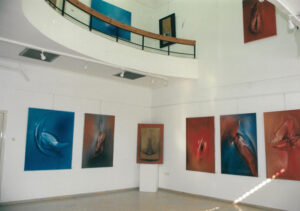
The first Years in Berlin 1997-2005
In 1997, Sabaliotis leaves Athens and moves to Berlin. He joins the BBK (the association of Berlin Artists), soon finds a large studio in Treptow and becomes part of the active art scene. In 1999, he curates the exhibition “Allegories of Matter” at the Contemporary Art Center Larissa together with its director Andreas Giannoutsos – a large exhibition with 15 international Berlin artists, funded by the Greek Ministry of Culture. It is so successful in Greece, that there will be a following exhibition in Berlin in the Willy Brandt House, one year later. More than 2,500 people visit the opening on the 20th June 2000 to see the works. On November 17th, Sabaliotis and the Willy Brandt House, as well as the Greek Embassy and the Greek Commu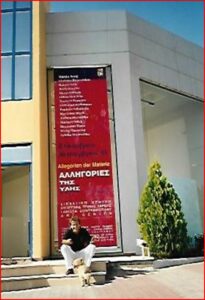 nity (represented by Dimitrios Kalantzis) organize a reading with Antonis Samarakis. Samarakis best-known works include the novel “The Mistake” from 1965. The artist and the writer, who has received significant literary prizes became close friends. A friendship that lasts until the authors death in August 2003.
nity (represented by Dimitrios Kalantzis) organize a reading with Antonis Samarakis. Samarakis best-known works include the novel “The Mistake” from 1965. The artist and the writer, who has received significant literary prizes became close friends. A friendship that lasts until the authors death in August 2003.
“Sender and Receiver” is the name of the large room installation from this time of renewed upheaval, which he presents in “Allegories of Matter”. The installation “Sender and Receiver” is a symbol of the living being in motion that receives and sends vital light and energy. Sabaliotis will present “Sender and Receiver” as well at the occasion of the “Diachrona”- exhibition 2001 in the Pinakothek Karditsa, the city will purchase the room installation for its permanent exhibition.
Berlin, the new location challenges the artist in many ways. Perhaps one of the reasons why it is an incredibly productive time. The „Philosophical Objects” are created, a series of large-format sculptures alongside countless small paper and canvas works in watercolor, pastel, acrylic and oil. The objects are made from a wide variety of natural and synthetic materials – salt, sand, oxidized metal alloys, wood shavings, styrofoam, aluminum or fabric. With them, Sabaliotis questions the relationship between humans and nature, things and matter. The first experiments with beeswax on bigger surfaces start.
His head is full of ideas, he can hardly work as much as he thinks of new things. Almost symbolic for this is the sculpture “Tachiteron olon o nous” (“The fastest of all is the mind, the idea”), which he presented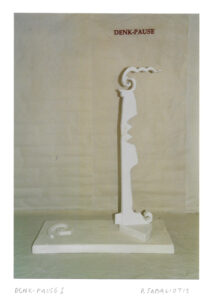 in 2003 in the Kesselhausmuseum in Berlin-Lichtenberg with a number of other room installations. “Tachistos nous” – (Engl: fast mind) is the prerequisite for creation, touch, communication and endoscopy, a look into things. Sabaliotis “rediscovers” the gold, which he had not dealt with since his training back then, which is enclosed in the wax and becomes the carrier. An inner light that brings an idea to the “daylight”, guides it to perfection, provokes changes in matter.
in 2003 in the Kesselhausmuseum in Berlin-Lichtenberg with a number of other room installations. “Tachistos nous” – (Engl: fast mind) is the prerequisite for creation, touch, communication and endoscopy, a look into things. Sabaliotis “rediscovers” the gold, which he had not dealt with since his training back then, which is enclosed in the wax and becomes the carrier. An inner light that brings an idea to the “daylight”, guides it to perfection, provokes changes in matter.
1997 Pantelis Sabaliotis is taking part in a major international exhibition in the temporary Prismahaus in Berlin, in 1999 in the “Dromologia III” exhibition in Larissa at the Center for Contemporary Art, the same year he curated at the same place “Allegories of Matter”.
Far from home he is occupied with the great philosophers. Above all Heraklit with his “everything flows” (ta panta rei) philosophy. But do you have to read the Ionian natural philosophers, do you have to know Heraclitus, the writings of the alchemists in order to understand the artist? Probably just as little as the stories about the gods and heroes of Greek mythology, since the established structures, the narrative thread would ultimately lead to different insights than those the artist intended. As mentioned above, he thinks thoughts further and gives them a new direction. He lives in the present, maybe he is even ahead of his time. “Sender and Receiver” stands for people and nature. For the discrepancy between a technocracy that determines our lives. For globalization and digitization, which leave emptiness behind, that has alienated us from nature and our actual coexistence. A technocratic society, he said in an interview with Frosso Pavlou 1999, demands visions (see below).
With his work Sabaliotis wants to give food for thought, to stimulate reflection, sometimes he just wants to provoke. With his interactive work “Liturgie“, which he showed in 1997 in the Prismahaus in Berlin, he mainly intended to do one thing: to involve the viewer physically, to touch his senses so that „he/she becomes aware that the earth is a wandering planet on which he/she is merely traveling.“ (From an interview with Frosso Pavlou, “Selides”- magazine, October 1999, pp 44-50). In another big interview (Maria Michaloudi-Angeli, 9. November 2003, Proinos Typos) he said it much more clearly: “Our society suffers from its development.”
In the years 1999–2004, his first years in Berlin in the Treptower Atelier, Pantelis Sabaliotis was particularly concerned with two series of works: Allegories and Phenomena. During this time, many assemblages and sculptures, room installations were created. While allegories were about adding artificial material, about an exaggerated tension between nature and technocracy, Pantelis Sabaliotis in Treptow 2000-2004 also worked on large-format canvases in which ideograms set the tone, Symbols and pictorial motifs. Scriptural art, which, after the “Geohistorima”- and „Phenomena“-series, are increasingly focused upon, as the exhibition in the Kesselhausmuseum in Berlin 2003 highlights. In this way the flat, small-scale room installations, for which he is inspired by the special architecture of this technician monument from the 19th century, are mostly complemented by ideograms.
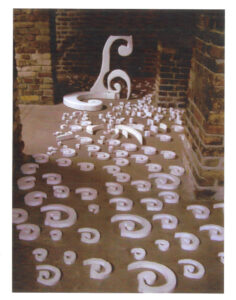 Words and pictorial motifs that float in space and symbolize the endless movement of things, creating a new rhythm and therefore a different perspective. One feels reminded of the thought processes of the natural scientist Max Planck, of whom the following sentence is passed on: “If you change the way you look at things, the things you look at change“. One Ideogram appears more frequently, becomes a manifest – “iero“, “holy”. The word is made up of the four elements water, fire, air and earth reduced to graphic abbreviations by the artist, a letter for each element, which, in their entirety, to a certain extent explain the cosmogony. The emergence of cosmic space, in whose dialectic even the smallest part participates. So it is not surprising that the artist also turned to miniatures, which are collected in the very complex series of works called “Living in Space“, a series of miniature objects and works on paper (watercolor, pastel, acrylic). As well here you can find a small artobject, called “Receiver” as part of that series that for Sabaliotis summarize the knowledge of a world that is constantly being reborn. A microcosm, representative of the big picture. Objects that according to the artist sharpen the senses because you have to look more closely. Hundreds of miniatures are created in the Treptower studio: Collages with glossy paper, opaque paints, acrylic and oil. Sabaliotis is always trying out new things such as scratching techniques and different materials.
Words and pictorial motifs that float in space and symbolize the endless movement of things, creating a new rhythm and therefore a different perspective. One feels reminded of the thought processes of the natural scientist Max Planck, of whom the following sentence is passed on: “If you change the way you look at things, the things you look at change“. One Ideogram appears more frequently, becomes a manifest – “iero“, “holy”. The word is made up of the four elements water, fire, air and earth reduced to graphic abbreviations by the artist, a letter for each element, which, in their entirety, to a certain extent explain the cosmogony. The emergence of cosmic space, in whose dialectic even the smallest part participates. So it is not surprising that the artist also turned to miniatures, which are collected in the very complex series of works called “Living in Space“, a series of miniature objects and works on paper (watercolor, pastel, acrylic). As well here you can find a small artobject, called “Receiver” as part of that series that for Sabaliotis summarize the knowledge of a world that is constantly being reborn. A microcosm, representative of the big picture. Objects that according to the artist sharpen the senses because you have to look more closely. Hundreds of miniatures are created in the Treptower studio: Collages with glossy paper, opaque paints, acrylic and oil. Sabaliotis is always trying out new things such as scratching techniques and different materials.
From 2000 to 2009 the artist also works as a lecturer for the Youth in Museum association. He leads workshops in the Kulturforum at Potsdamer Platz or the Pergamon museum. They have titles like “Greek Dance of Gods”, “Everything Flows”, “Perfect World in Mosaic” or “The Olympic Idea” and familiarize children and young adults with ancient Greece, everydaylife, artistic techniques and mythology. The work with them is important to Sabaliotis, it means a lot to him to promote creativity and knowledge. For the event “Lange Nacht der Museen” (a special event in Berlin, that allows visitors to discover the city’s museums a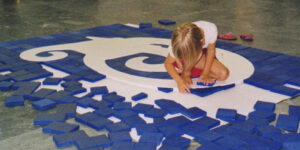 t night) in 2002 in the Kulturforum he designed the performance “Everything flows”, which he will present three more times in 2003: on the occasion of the “Fairytale Days” (a fairytale themed event in the Kulturforum) as well as for the Literary Culture Festival and the Culture Night in the Winckelmann Museum in Stendal. His current work of art can be described as an oversized puzzle that consits of 400 pieces made of wood with pigments on an area of 240 x 180 cm. It shows the deep blue of the Greek sea with a white ship that travels from antiquity into tomorrow.
t night) in 2002 in the Kulturforum he designed the performance “Everything flows”, which he will present three more times in 2003: on the occasion of the “Fairytale Days” (a fairytale themed event in the Kulturforum) as well as for the Literary Culture Festival and the Culture Night in the Winckelmann Museum in Stendal. His current work of art can be described as an oversized puzzle that consits of 400 pieces made of wood with pigments on an area of 240 x 180 cm. It shows the deep blue of the Greek sea with a white ship that travels from antiquity into tomorrow.
In 2000 Sabaliotis can be seen in the Museum of Byzantine Art in Ioannina. In 2001 he took part in the exhibition of the Greek Ministry of Culture in Technopolis, Athens, and in the second International Biennale New Watercolor in Fulda. In 2002 he was represented at the Fürstenwalde Gallery in the exhibition „Miniatur in der bildenden Kunst“ (“Miniature in Fine Arts”). In 2001 the Pinakothek in his hometown Karditsa presents “Diachrona“, a retrospective that shows a small excerpt from 25 years of artistic work by Pantelis Sabaliotis (artworks he created from 1974 to 1999). Proposed by the Greek Embassy in Berlin, the artist will represent Greece in 2002 in the art calendar published by the Ruksal Printing Company, under the title: “12 European Artists”. In 2003 the Kesselhausmuseum in Berlin is an impressive backdrop for the Phenomena series.
The Kesselhausmuseum Herzberge is a special place. An old technical and industrial monument that has been converted into a museum and presents the artist with special spatial challenges. Sabaliotis will solve them with his own elegance, using extensive room installations with ideograms in the focus. As already said above, Sabaliotis began to study ancient scripts in the late nineties; unsolved riddles like the characters on the Phaistos disc fascinate him as much as graphic characters and abbreviations from archaic times. The writing systems Linear A and B from the 15th-17th centuries BC Crete are on his mind as well. At the beginning, at the end of the nineties, he embedded symbols and motifs in drawings only from time to time. Now they will gradually develop a life of their own, leave one-dimensionality and grow into independent objects. The artist tirelessly develops hundreds of his own symbols and ideograms. A world of its own of scriptural art with symbols for family, for love, for home, for the forces of nature.
Exchange and transformation, visible and invisible, are two essential aspects of life itself, which fascinate the artist and are often visualized in his artwork. In the subject, in the construction, in many of the titles, which often imply travel or movement. Two things that are essential for the artist, the basis of life and its abundance.
In the infinity of the world, of space, he once noted in a workbook, the human mind is like a little top trying to find its balance, its place somewhere. An infinite number of thoughts, views, philosophies flow through his mind, form a river that becomes a lake. A lake in which the individual small objects reflect one another, mirror one another, repel one another, nestle against one another. Just like with water, there is a constant back and forth under the legal static basis, movement belongs.
For a summer in 2004, the artist returns to Hydra, the small island on which he experienced an incredible artistic development in four years of nearly complete seclusio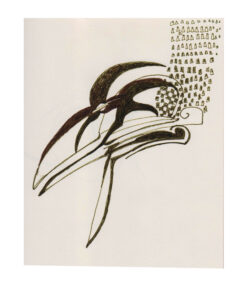 n. No other place has had such a lasting impact on his work, contributed to such a decisive change. Hydra means turning towards materiality, discovery of matter, departure towards object art. Here the decisive step was taken towards those of the artist’s works, that are unique in form and expression. In the 2004 exhibition “Liturgy in Harmony with Nature” (“Liturgies se simfonia me tin fisi”) in the Historical Archive Museum Hydra, Pantelis Sabaliotis shows works that were partly created during his time on Hydra from 1989-1993 and those that were realized in Berlin, whose core is still materials from the island Hydra.
n. No other place has had such a lasting impact on his work, contributed to such a decisive change. Hydra means turning towards materiality, discovery of matter, departure towards object art. Here the decisive step was taken towards those of the artist’s works, that are unique in form and expression. In the 2004 exhibition “Liturgy in Harmony with Nature” (“Liturgies se simfonia me tin fisi”) in the Historical Archive Museum Hydra, Pantelis Sabaliotis shows works that were partly created during his time on Hydra from 1989-1993 and those that were realized in Berlin, whose core is still materials from the island Hydra.
In May 2005, Pantelis Sabaliotis will lead the 10-day workshop “Inside, Outside” in Karditsa in the Old Agora, in which the most diverse age groups will participate with great enthusiasm. Wooden stencils in the shape of dolphins play an important role in this. Because for the artist they symbolize the perfect society and he is convinced that we can learn a lot from them, from their group spirit, their partnership, their communication and their great sensitivity towards nature.
In addition to the dolphins, stencils in scissors shape play another essential part in the workshop. The form of the scissors gives the participants the opportunity to express their personal opinion on behalf of interpersonal relationships, a relationship that determines our lives.
“While the dolphins live the ideal, the scissors symbolize that which unites in the partnership, and at the same time also that which drifts apart”, the artist described his choice of the “image carrier”. The scissors are therefore a clear sign, because they are also sharp, cutting and hurtful. (From the interview with Dimitris Parlavantza, in the magazine “Kochlias”, issue 4, October 2005, pp. 36-39).
The last Years in Berlin 2006-2011
At the beginning of 2006, Sabaliotis moved into a new, larger studio: the UCW studio building in Berlin-Wilmersdorf – his last workplace in the Sigmaringer Straße 1. Two large interconnected rooms (120 m²) in a former health department, converted by the BBK 2005 in workspaces or artists.
Pantelis Sabaliotis experimented a lot with sand, salt and other rather crusty materials in the early years in Berlin, from now on two other materials will determine his works until the end of his creative period: beeswax and gold leaf.
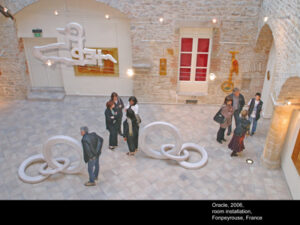 “Metaplaseis” (“transformation”) is the name of the penultimate series in which gold and leaf metal play an essential role. “The reflection of gold“, he once said, “is like the idea that breaks free from the source of the subconscious and penetrates into the consciousness.” In many of the works from 2004 to 2006 he tried to unite this contrast – to give space to the oxidation, a progressive process of decomposition, next to the imperishable shine. An energetic dualism that already lives from the contrast.
“Metaplaseis” (“transformation”) is the name of the penultimate series in which gold and leaf metal play an essential role. “The reflection of gold“, he once said, “is like the idea that breaks free from the source of the subconscious and penetrates into the consciousness.” In many of the works from 2004 to 2006 he tried to unite this contrast – to give space to the oxidation, a progressive process of decomposition, next to the imperishable shine. An energetic dualism that already lives from the contrast.
Jean-Gabriel Jonin, a well-known French art critic and author, summarizes in the opening speech on the occasion of the 2006 exhibition at Maison Fonpeyrouse in Cordes sur Ciel: “If there is such thing like metaphysical materialism, then it exists in the work of Pantelis Sabaliotis.”
Warm orange is created when iron, sun and sea water combine. Green, as it appears more often on the canvas works of the “Metaplaseis”-series, arises from a combination of gold and beeswax. In addition, there are color nuances that arise over time: in long-term decomposition processes, for example, when silver and salt meet or gold with a high copper content is used, which intentionally sets off a slow oxidation.
In the exhibition “Traces and Metaplaseis”, that takes place in the Körnerpark Gallery in 2008, Sabaliotis will present gold works for the last time and already artworks that focus on honeycombs, that already occupy him and which he will present in his last exhibition in 2009: “Kypseles“.
“The millennia-old painting technique of encaustic, in which color pigments are applied with wax in order to make them glow, combines a wide variety of materials in Sabaliotis’ work and becomes – for example in the change that beeswax undergoes through fire – a symbol itself for time and transformation“, Prof. Dr. Stefanie Endlich (Professor at the University of the Arts Berlin/ UdK) specifies in her opening speech at the exhibition “Traces and Metaplaseis”.
The artist removes the encaustic from its original purpose, like a thin layer of skin to protect and define the actual painting. The wax becomes the protagonist, it dominates, it completely 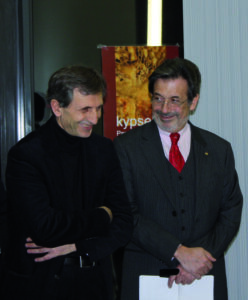 occupies the surface and becomes an independent work of art. He leads the wax back to its actual origin, develops comb structures, similar to honeycombs, which are covered by layers of wax that are centimeters thick. He creates honeycombs of memories that simultaneously appeal to all the senses, while developing their intense bewitching smell when its warm. He creates great, large works, 2.50 x 2.00 meters. In arduous days, weeks and months of labor, he applies layer by layer until the work is completed. Little does he suspect that the wax, which has been the focus of his work for a long time now, anticipates his death. That it will be his own lifetime that he conserves in the large-format works.
occupies the surface and becomes an independent work of art. He leads the wax back to its actual origin, develops comb structures, similar to honeycombs, which are covered by layers of wax that are centimeters thick. He creates honeycombs of memories that simultaneously appeal to all the senses, while developing their intense bewitching smell when its warm. He creates great, large works, 2.50 x 2.00 meters. In arduous days, weeks and months of labor, he applies layer by layer until the work is completed. Little does he suspect that the wax, which has been the focus of his work for a long time now, anticipates his death. That it will be his own lifetime that he conserves in the large-format works.
This work is the result of four decades of experience, research and almost alchemical knowledge. The artist’s works continue to change over time through sun and light, energetically, immortal in a quiet and yet incessant transformation process. The pure beeswax includes pigments and gold, making it „inviolable” and yet lively through the action of light and temperature.
After completing his last exhibition, Pantelis Sabaliotis works as a curator at the municipal Wedding Gallery Berlin-Mitte until his death in October 2011. He develops its main program and not only exhibits internationally known artists, but also promotes the artistic development of children and young people with formats such as the Jugendkunstpreis Mitte (an award for young people in Berlin Mitte) or the workshop “Kids Guernica”, that deals with war and peace. There are interesting collaborations with the ifa (Institute for Foreign Relations) and the Finland Institute. He is a committed doer and a networker. But he will have little time left for his own work.
The few days of the week, he does not spend in the gallery, but in his studio, he dedicates to a new series of works. After the honeycomb, the artist’s attention is again increasingly directed towards gold. The last series of artworks by Pantelis Sabaliotis, he would not complete, gives gold a completely different direction than in the “Metaplaseis”-series. Once he was looking for the light of the north in Lund, now he searches the pure surface in gold. A liquid-looking gold coating that lays over the surfaces, he had “staged”. The almost molten, lively surface meant catharsis, clarity and spiritual purification to him. An energy boost to infinity. Golden like the light of the sun, spirit, immortality. Companion to another dimension …
Dimitrios Kalantzis writes in a newspaper article: “Proinos Typos, Politismos Technes”, from 29.9.2002 about Sabaliotis:
“A modern and daring artist, who never lost touch with Greek artistic development through the centuries.“
Addendum: The Cyclists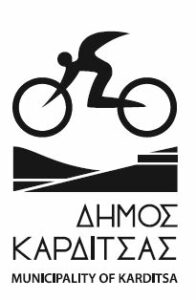
The municipality of Karditsa, to which the small hometown of the artist Agiopigi belongs, is an important economic and cultural center in the plains of Thessaly. Located on the Greek mainland, in central Greece, roughly halfway between Thessaloniki in the north and Athens in the south. Since joining the EU, Karditsa has been a pioneer when it comes to becoming a bike-friendly city. As early as 2018, “The Cyclist” (“Ouranios Podilatis“), designed by Pantelis Sabaliotis in 2005, was installed as several large-scale sculptures glowing at night over the central entrances and exits of the city. Karditsa was awarded for the first prize by the EU as the most bike-friendly city in the category of small communities as part of the Europe-wide Mobility Week Competition, in May 2020. In the summer of 2020, the city council decided to make the winged cyclist the city symbol, which was officially declared in 2021.
Promotional video of the city of karditsa on the occasion of the Mobility Contest 2019